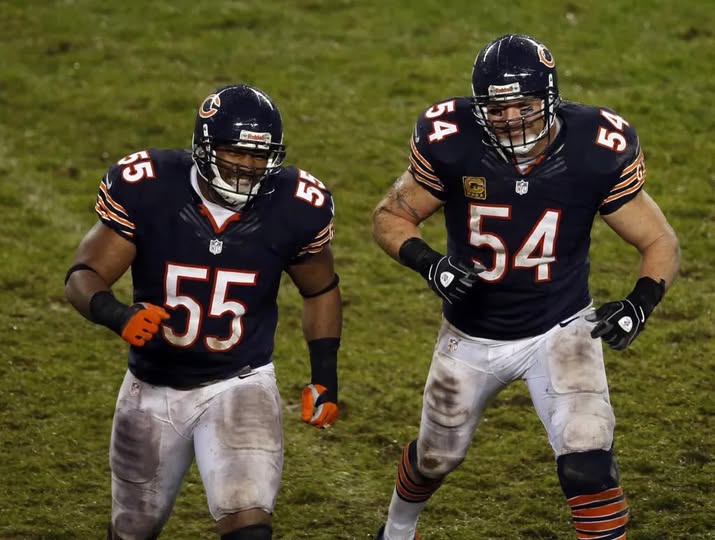There was a time in the NFL when offenses feared stepping foot into Soldier Field. When the cold, wind-whipped air of Chicago didn’t just sting—it paralyzed. But the weather wasn’t the only thing freezing quarterbacks in their tracks. In the heart of the Windy City, two monsters of the Midway roamed the gridiron, hungry for contact, relentless in pursuit, and allergic to defeat. Lance Briggs and Brian Urlacher weren’t just linebackers. They were an era.
To understand the fury Briggs and Urlacher brought to the field, you have to look back to a period when defense was an art form in Chicago—one sculpted by violence, instincts, and precision. These two didn’t just complement each other; they were each other’s accelerant, gasoline meeting fire. Together, they turned the Bears defense into one of the most feared units of the 2000s, and every Sunday, they delivered punishment with surgical intensity.
Brian Urlacher was the face of the franchise, a towering presence at 6-foot-4, 258 pounds with the speed of a safety and the brain of a coordinator. A freak athlete out of New Mexico, he made the seamless transition from collegiate do-everything defender to the middle linebacker of one of the most storied franchises in sports. His arrival in 2000 marked the dawn of a new era for Chicago. From his first snap, it was clear Urlacher wasn’t built like other linebackers. He moved like a tight end, hit like a freight train, and read plays like a seasoned veteran. And above all, he led.
Enter Lance Briggs. Drafted in the third round in 2003 out of Arizona, Briggs brought a fire all his own—one that blazed differently but burned just as hot. While Urlacher was the field general, Briggs was the heat-seeking missile. He played with a violent purpose, a chip on his shoulder the size of Illinois. Despite not having the same draft pedigree as Urlacher, Briggs quickly showed he was cut from the same steel-forged cloth. His sideline-to-sideline speed, bone-jarring hits, and nose for the ball made him indispensable. In truth, it didn’t take long before Bears fans stopped seeing them as separate entities. They were a unit, a force of nature.
Together, Urlacher and Briggs anchored the Bears defense through the early and mid-2000s, culminating in their unforgettable 2006 season—a campaign fueled by dominance, swagger, and brute force. That year, the Bears boasted one of the NFL’s best defenses, holding opponents to just 15.9 points per game. Urlacher won his second NFC Defensive Player of the Year award. Briggs made the Pro Bowl for the second straight season. And every offensive coordinator in the NFC quietly cursed the calendar when they saw Chicago looming.
What made the duo unique wasn’t just the talent; it was the synergy. Urlacher’s deep zone awareness allowed him to patrol the middle like a hawk, breaking up passes and confusing quarterbacks. Meanwhile, Briggs thrived in the Tampa 2 scheme, attacking the line of scrimmage with fury, swallowing up running backs before they reached the second level. Their understanding of each other’s responsibilities created a flowing ballet of destruction—each step measured, each hit intentional, each game a masterpiece of defensive execution.
And the highlights? They’re endless. Urlacher chasing down Michael Vick in open space. Briggs leveling Adrian Peterson with a form tackle so clean it belongs in coaching clinics. Their synchronized efforts to collapse pockets, diagnose screen plays, and make life a nightmare for signal callers week after week. Their communication was near telepathic—if Urlacher dropped, Briggs blitzed. If Briggs spied the quarterback, Urlacher shot the gap. Like chess masters, they moved the pieces of the defense until every offensive plan unraveled.
Off the field, they couldn’t have been more different, and yet, that only added to the magic. Urlacher was often stoic, measured, the embodiment of discipline and control. Briggs was outspoken, passionate, and occasionally controversial. But the fire never spilled into dysfunction. Instead, their differing personalities meshed into a chemistry that electrified the team and solidified the locker room. They were leaders in different ways, but each commanded respect.
It’s no coincidence that in the years Briggs and Urlacher shared the field, the Bears consistently ranked among the NFL’s top defenses. Between 2003 and 2012, Chicago led the league in takeaways, turnovers forced, and defensive touchdowns. In 2006, they carried the Bears all the way to Super Bowl XLI—not with a high-powered offense or a Hall of Fame quarterback, but with raw defensive fury. Though they fell short in the title game to Peyton Manning’s Colts, the path there was paved with the blood, sweat, and ferocity of two linebackers at the peak of their powers.
Over their careers, the accolades piled up. Urlacher was named to eight Pro Bowls, earned four First-Team All-Pro nods, and was inducted into the Pro Football Hall of Fame in 2018. Briggs? Seven Pro Bowl selections, three All-Pro appearances, and a legacy etched into the heart of Chicago. Despite never reaching Canton, Briggs’ impact remains undeniable. His partnership with Urlacher defined a decade of defense and revived the city’s long-standing love affair with hard-hitting football.
But beyond stats and trophies, their legacy lies in the culture they built. Young defenders wanted to be like them. They set the tone in practice, held teammates accountable, and never backed down from a challenge. Even as offensive innovations swept the league, Urlacher and Briggs stood as reminders that, sometimes, defense still wins championships—or at the very least, demands your respect.
And fans? They felt it. The roar of Soldier Field after a goal-line stop. The collective inhale as Urlacher baited a quarterback into a throw, only to pick it clean. The eruption when Briggs scooped up a fumble and took it the other way. These weren’t just plays; they were moments of shared adrenaline, the kind that stitched fans to their team forever.
Today, in the age of analytics and high-flying offenses, it’s easy to forget the era of linebacker-driven dominance. But every now and then, a hit montage resurfaces on social media. Urlacher’s bald-headed intensity flashes across the screen. Briggs comes flying in from the weak side, decapitating another unsuspecting back. And for a brief, glorious moment, fans remember. They remember what it meant to watch two warriors patrol the field like modern-day gladiators.
They remember the fear they inspired, the joy they delivered, and the standard they set.
The Briggs-Urlacher years weren’t just a highlight reel—they were a blueprint. A reminder that when talent, toughness, and trust converge, legends are born. And in Chicago, on those cold Sunday afternoons, two linebackers gave fans something to believe in—something to roar for.

